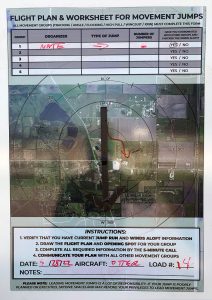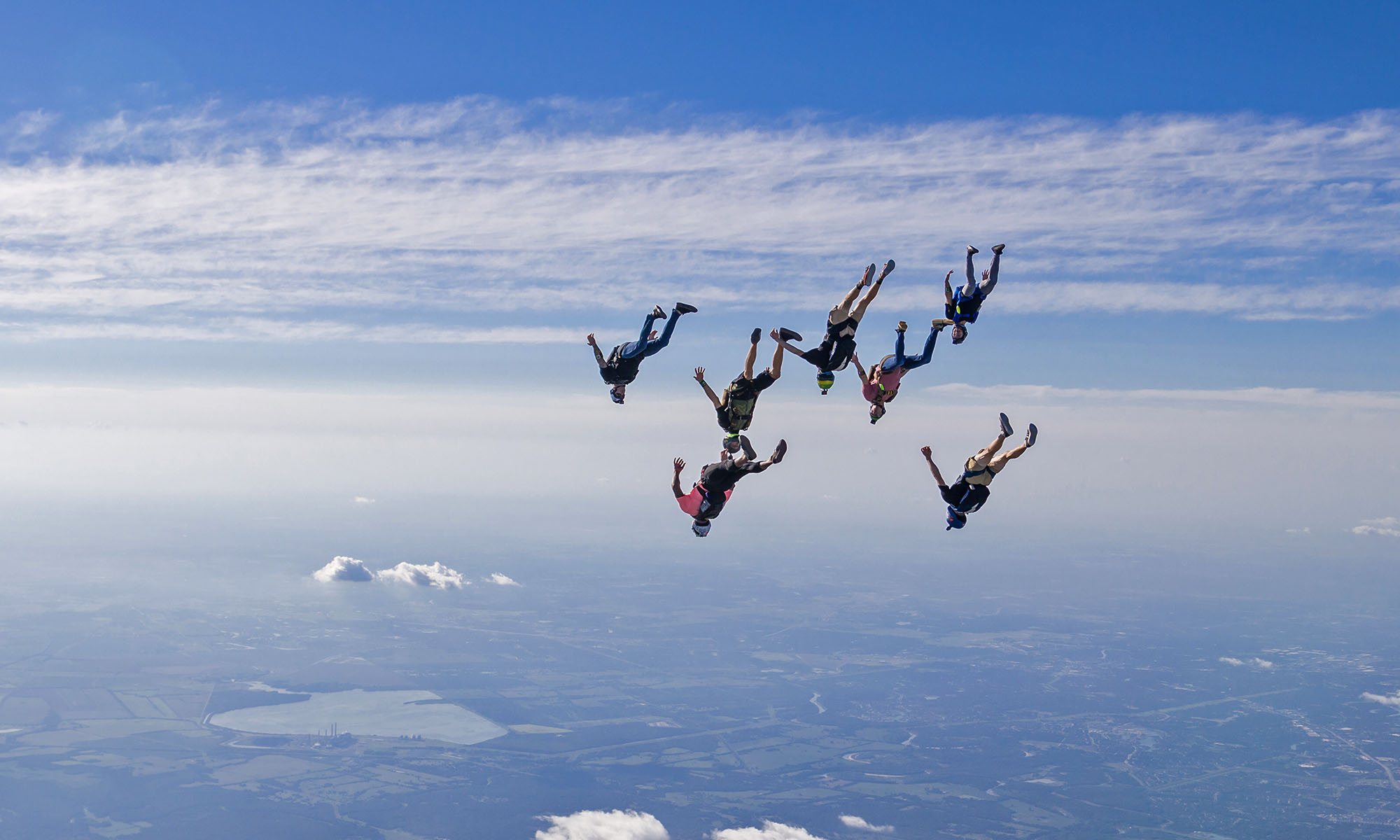Horizontal movement jumps are fun… free flowing… and inherently potentially much riskier than jumps that fall straight down. Any jump in which jumpers plan horizontal movement other than tracking for separation after breakoff requires good planning and execution to minimize the additional risks to everyone on the load.
Above photo by Daniel Angulo!
That responsibility is 100% the job of the organizer(s) doing movement jumps, and it should not be taken lightly.
Only Spaceland-approved movement leaders may lead movement jumps of any size at Spaceland.
Spaceland has developed several policies for tracking/angle jumps with the blessings of our staff and experienced tracking organizers. Please read all of and follow these guidelines to help keep us all safe.
Movement Jump Safety Basic Guidelines
- Design your jumps and select your group with safety in mind. Consider jumper experience, flight path, group size, and winds to develop a plan that will minimize any chances of compromising other groups’ airspace. Then discuss the plan with the rest of your load, adjusting as needed to maximize safety. If you need help, ask a more experienced movement leader and/or consider getting coaching before leading these jumps.
- Use the dry erase board in the loading area to draw your flight path for the jump, and make sure all other movement groups on the load do as well, so you can visualize the plans and adjust as needed to divide the airspace safely. Jump run is marked with a black magnetic arrow.

Movement jump planning board (Spaceland Houston) – Click to expand… Can you spot the problem with this flight path? If not, please don’t lead any movement jumps until you can.
- DO NOT break off towards the line of flight.
- No more than 2 movement groups of each discipline per load without expressed approval from an S&TA or movement evaluator.
- Always have a straight-down jump as a backup plan in case conditions such as clouds, changed jump run direction, modified exit altitude, etc., will make your primary plan unsafe.
- New to these jumps? Jump with an experienced organizer/coach until you fully understand the risks and have sufficient technique and awareness to not increase these risks.
- Each jumper should carry a mobile phone in a secure pocket, and program the following three numbers into it: Manifest (512-488-2214), ICE or In Case of Emergency number (family/responsible person for us to contact in case you are hurt), and the jump organizer. Call 911 first if you land out and are badly hurt, and call us second. Call us also if you land out but are unhurt to let us know you are OK and if you need a ride. Also call your jump’s organizer with the same information.
- These jumps have a higher chance of landing off the DZ. Also, since you’ll open away from the usual jump run, we may not see you if you land out or have a malfunction. Don’t expect a ride if you land out; we’ll do our best to get you if we see you, but assume you’re on your own. If you have a cutaway, note where you opened so we can help you find your main. Identify an appropriate alternate landing area right after opening and fly conservatively to it, then make the phone calls described below.
- Equipment Recommendations: We HIGHLY recommend AADs and audible altimeters for all skydivers (we can’t encourage this enough!). Many organizers will not include jumpers without AADs and audibles in their group, with very good reason!
- Make sure to manifest your group as a movement jump. If you don’t declare your intentions with manifest, the increased last-minute load organizing may result in you missing the load.
Suggested Minimum Experience for Movement Jumps
| Jump type/role | Minimum experience | Notes |
| Movement jump with coach | 100 jumps | Must jump with an experienced movement coach/organizer. |
| Solo movement jump | 200 jumps | Must be an approved movement leader. |
| Small group follower (3 jumpers max) | At least 100 jumps | We recommend that your first 10 movement jumps be with an experienced organizer/coach. After at least 100 of these small group jumps, you may be ready for larger groups. |
| Group movement jumps (4+ people) | At least 200 jumps | We recommend that your first 100 movement jumps be small groups with an experienced organizer/coach before flying with groups of 4 or more jumpers. |
| Lead movement jumps | At least 750 jumps | Leaders must be approved by Spaceland before leading anything. We recommend that leaders have at least 200 tracking jumps as a follower and take a leading course or attend a leading briefing. |
* Individual experience and skill vary widely. You may be more or less skilled at a certain jump number than others, so please consult with our safety officers/instructors/more experienced organizers before trying new types of jumps or if you have any questions at all.
Approved Leader Requirements
- You MUST be a Spaceland-approved leader to lead any movement jumps! See above minimums table. Consult a movement evaluator, S&TA, or the drop zone manager for more information on becoming an approved leader.
- Leaders must be effective communicators who work well with others. Cooperating with other groups/leaders is a crucial component of creating a safe movement jump culture.
- Make a flight plan that ensures you won’t fly into others’ airspace and lets your group land on the DZ. If your jumper(s) land off due to poor planning, you may be barred from organizing these jumps until the problem has been solved.
- Screen all jumpers for skill/experience needed for the type/size of the dive. We suggest that you do not allow open participation without regard for each jumper’s skill and experience (no zoo dives).
- You are responsible for the safety of yourself, your group, and its plan. Select your skydivers and your plan carefully.
- Leading on your back is NOT recommended.
- Design your skydive to maximize the safety of all groups on the load.
- Design your skydive around the least experienced flyer.
Ensure that everyone on the jump knows:
- These jumps have an increased risk of forceful freefall collisions due to combined horizontal/vertical movement, and many people can be in your blind spot. Reduce risks by keeping groups small, especially with less experienced jumpers, and thoroughly briefing good technique and awareness.
- Getting clear of the normal jump run is essential.
- These jumps require a safety-focused plan. Know your jump’s plan and DO NOT deviate from it unless danger requires it.
- Determine where other jumpers/groups are before flying back towards jump run and the landing area under canopy.
- Know what to do if a jumper is left behind in freefall.
Exit Order
- Leaders should be able to identify a wide variety of exit order considerations including scenarios for large groups, multiple moving groups, high winds, variable jump runs, wind shears, etc.
- Leaders should value horizontal separation over vertical separation when considering exit order.
How do I get approved to lead movement jumps?
- See minimum requirements above
- Talk to the DZ Manager
- Complete a written questionnaire
- Attend a course or briefing about leading movement jumps
- Conduct a supervised skydive with a Movement Jump Evaluator
As with other type of skydives, flyers involved in incidents caused by unsafe planning/execution may be prohibited from jumping until they obtain further training/guidance from organizers/safety officers.

